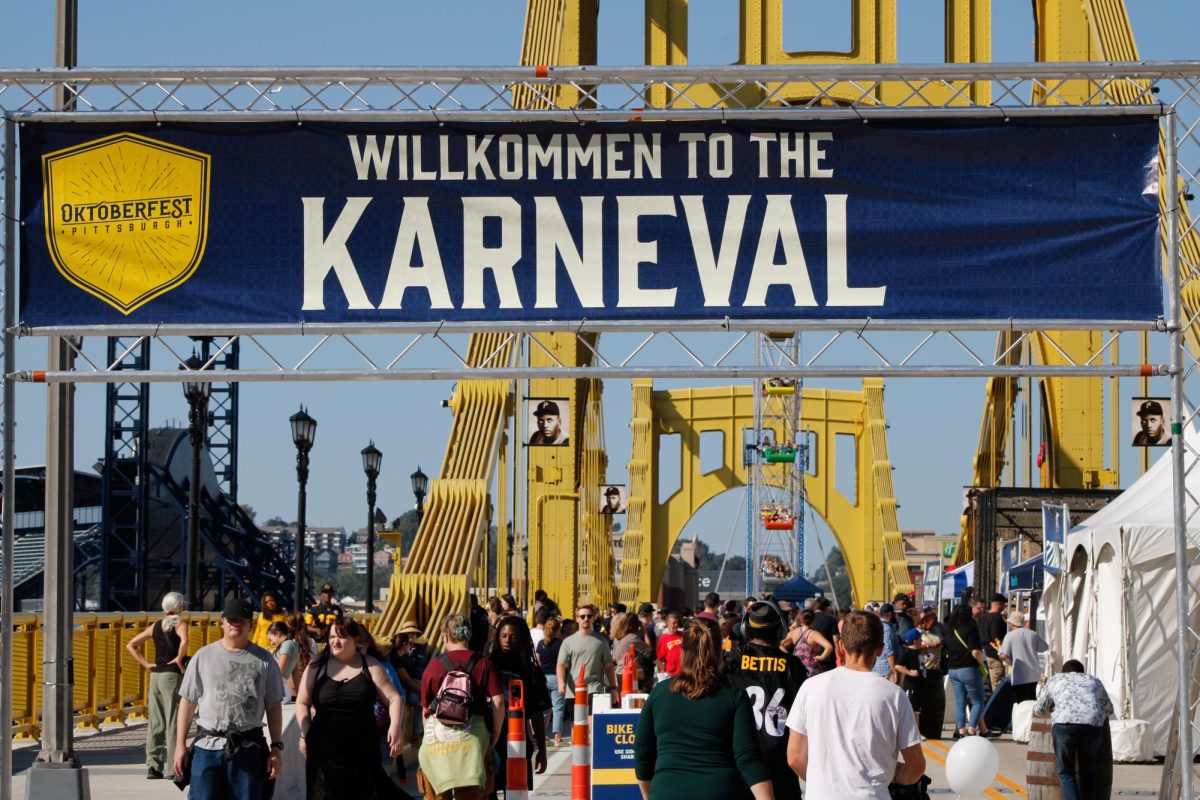It’s not often that one can experience a hardcore folk punk band, traditional Bavarian hats and spaghetti ice cream all in one night in downtown Pittsburgh, but Oktoberfest Pittsburgh created that opportunity. From Oct. 3-13, beer and Bavarian decor decorated Market Square and the Sixth Street Bridge to bring a taste of Germany to the people of Pittsburgh.
Oktoberfest Pittsburgh is best characterized by one word — community. The festival is set around a large tent filled with tables, lights and laughter. Festival attendee Donna DiNardo spoke on the communal table and the entertainment it provided.
“The communal table, it feels like a German beer hall. It’s really a good idea. We’ve met people from other parts of Pittsburgh, and that’s been really fun, too,” DiNardo said.
The tables are the central focal point of the communion in the festival. Music blared from one side of the tent, a beer line hugged the other and the tables hosted conversations from all parts of the city.
The German-style seating of a beer hall is a major part of the festival’s food experience, as it lies in the center of the beer, dessert and food lines. Primanti Bros. fed the festival, serving a limited Bavarian menu. Items ranged from bratwurst and pretzels to strudel and spaghetti ice cream, and beer tents were available to those of age.
University of Pittsburgh alumna and festival attendee Pamela Harwell raved about the pretzels and the food at Oktoberfest.
“The pretzels were the best I’ve ever had, anywhere. Anywhere. It’s delicious,”
Harwel said.
Long lines were common as the festival only hosted one food tent and one dessert tent.
Music was featured heavily during the event, with different bands performing every night of the festival. The majority of the lineup included German and Bavarian folk music to keep the traditional Oktoberfest polka sound, but each band brought its own spin to traditional tunes.
Folk punk band “Lemon Bucket Orkestra” played Saturday, Oct. 5, and brought an upbeat, anarchist sound to traditional Balkan and Eastern European music. The folk punk spin introduced many to polka music, as the crowd was filled with a combination of young and old waltzing, moshing and dancing to the string and horn combination.
Outside of food and music, entertainment was bountiful at Oktoberfest Pittsburgh. For those who love heights, the Sixth Street Bridge (also called the Roberto Clemente Bridge) was home to a Ferris Wheel, where passengers soared above the festival to get a bird’s eye view of Pittsburgh for $5.
On each Saturday and Sunday of the festival, dachshund owners and lovers brought their pups onto the public stage and watched them run in the Dachshund Race. On the same days were the Feats of Strength competitions, which included activities like keg lift racing and stein holding. A Kinder play area was open to those with younger children, hosting various crafts and games from noon to 6 p.m. on the weekends.
This year marked the first time that Oktoberfest came to downtown Pittsburgh, thanks to the Pittsburgh Downtown Partnership. Peter Quint, a member of the Downtown Partnership board who was clad in traditional German dress on Saturday night, discussed the unifying aspect of community over a popular shared heritage in Pittsburgh.
“Pittsburgh has a lot of the roots in German culture, and so it’s one of the things to celebrate in part of the culture that actually built Pittsburgh,” Quint said.
He emphasized how important it was to the board of the festival that it not only celebrated German heritage but also created a unified Pittsburgh community. Quint also noted the lack of entertainment Downtown during early fall and hoped Oktoberfest brought a fun, new activity to the city.
Oktoberfest Pittsburgh organizers were very intentional about bridging old Germany with modern Pittsburgh and said they worked hard to mend the two cultures and time periods represented at the event.
“Usually Bavarian color is the light blue with the white. In this case, [graphic designers for the festival] use the darker blue with the white,” Quint said. “So there’s still a little bit paying homage to the old colors. But at the same time, it’s very unique and very, very Pittsburgh, down to all the logos and everything.”
Quint said that being intentional about mixing in modern aspects of the festival, like updated colors and folk punk music, aimed to create a larger community celebrating Pittsburgh’s unique German heritage.


